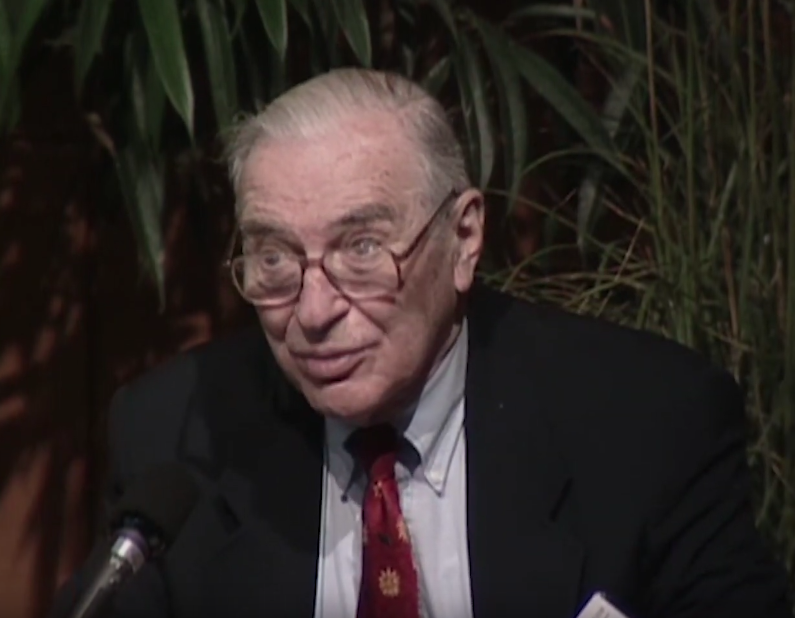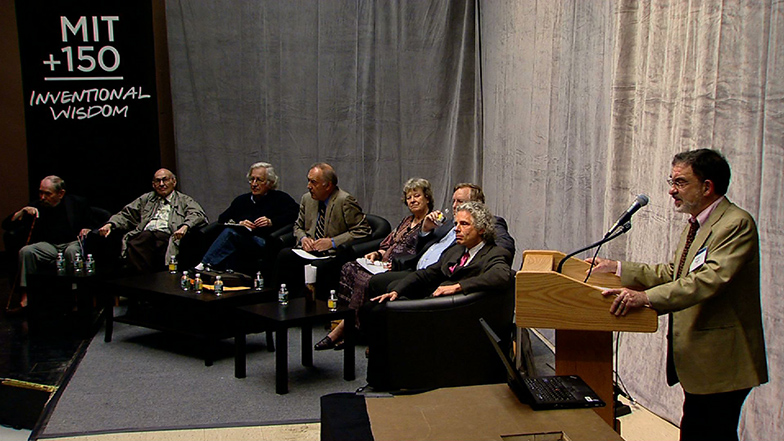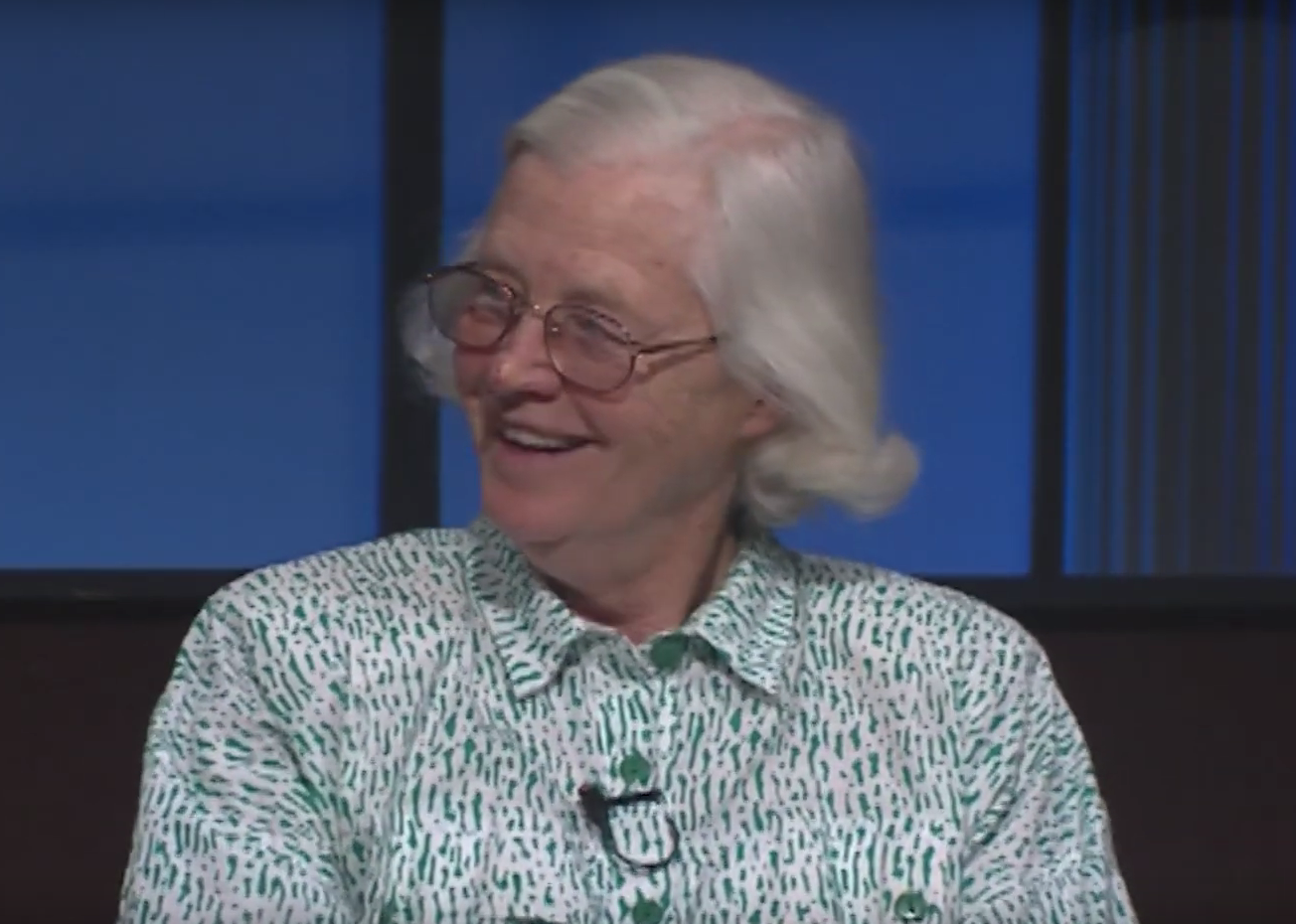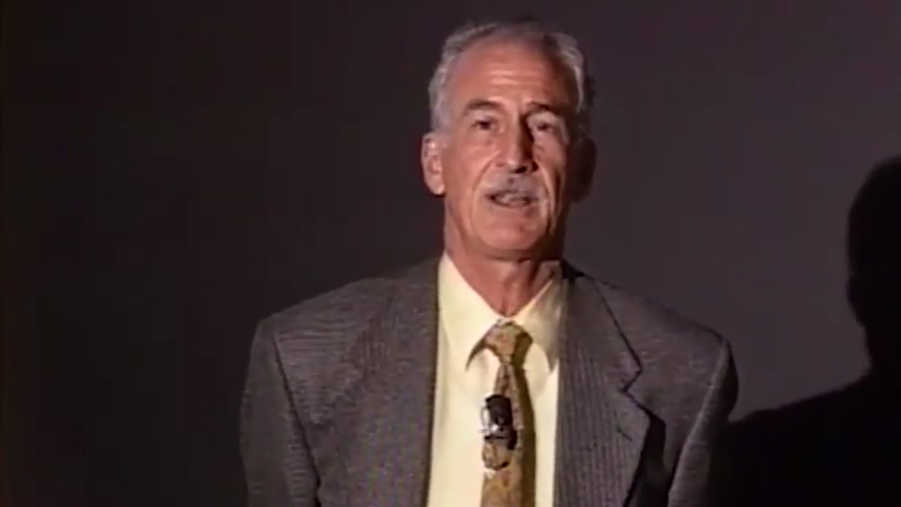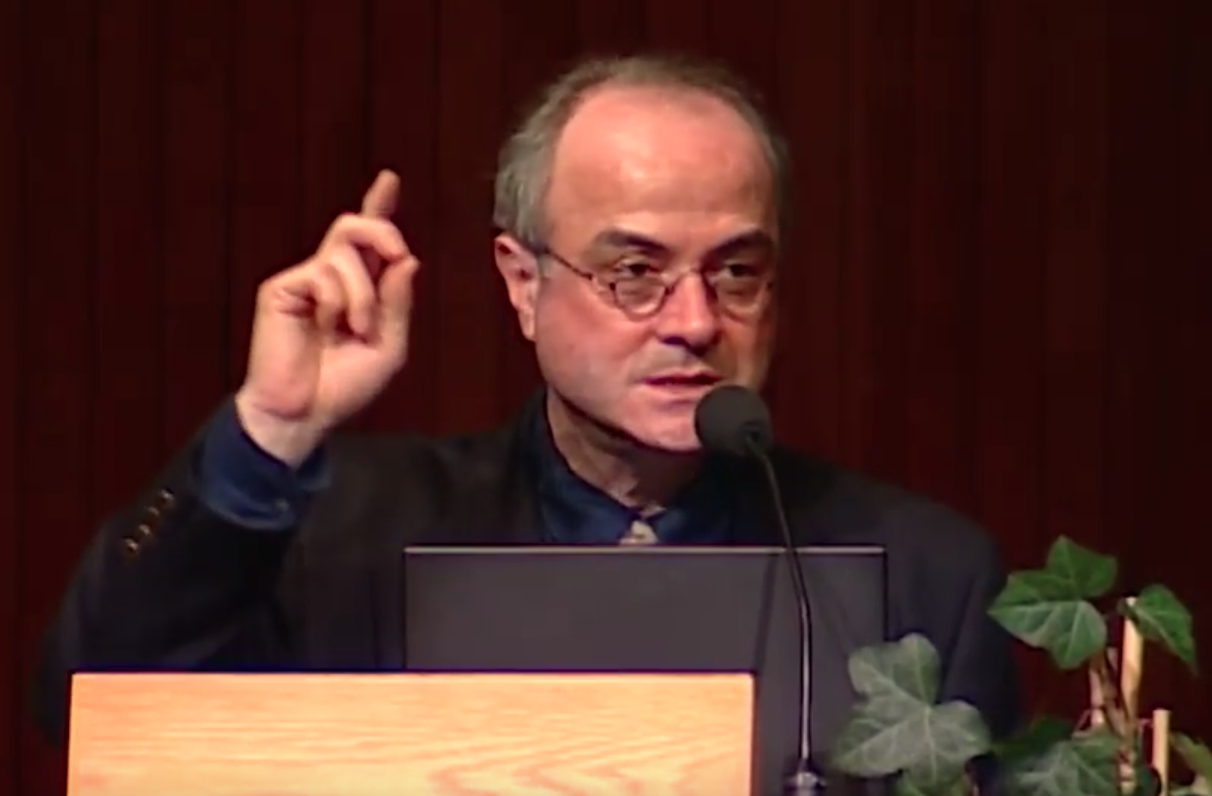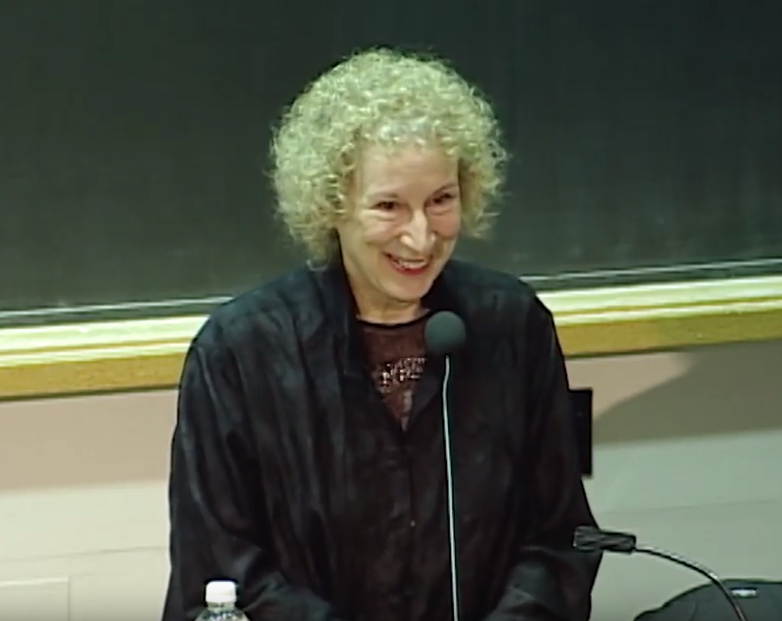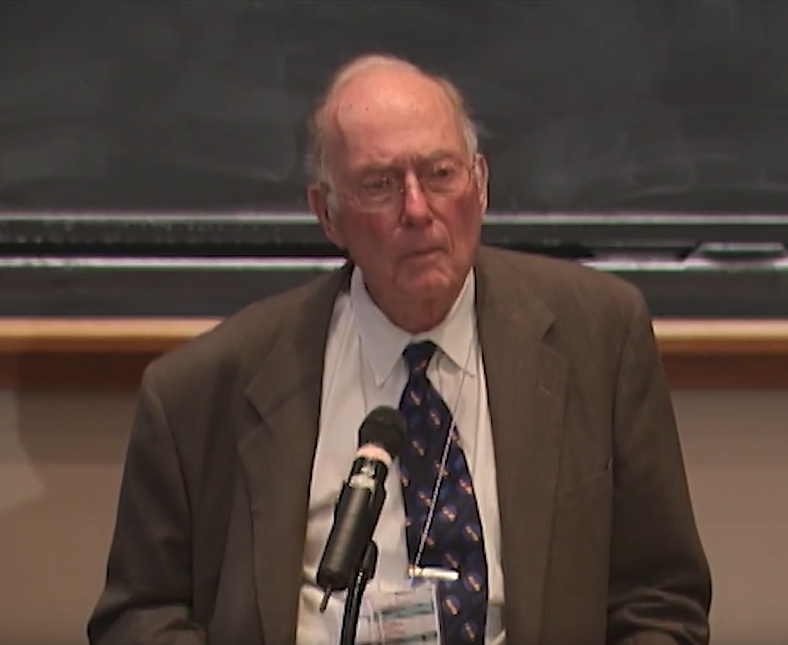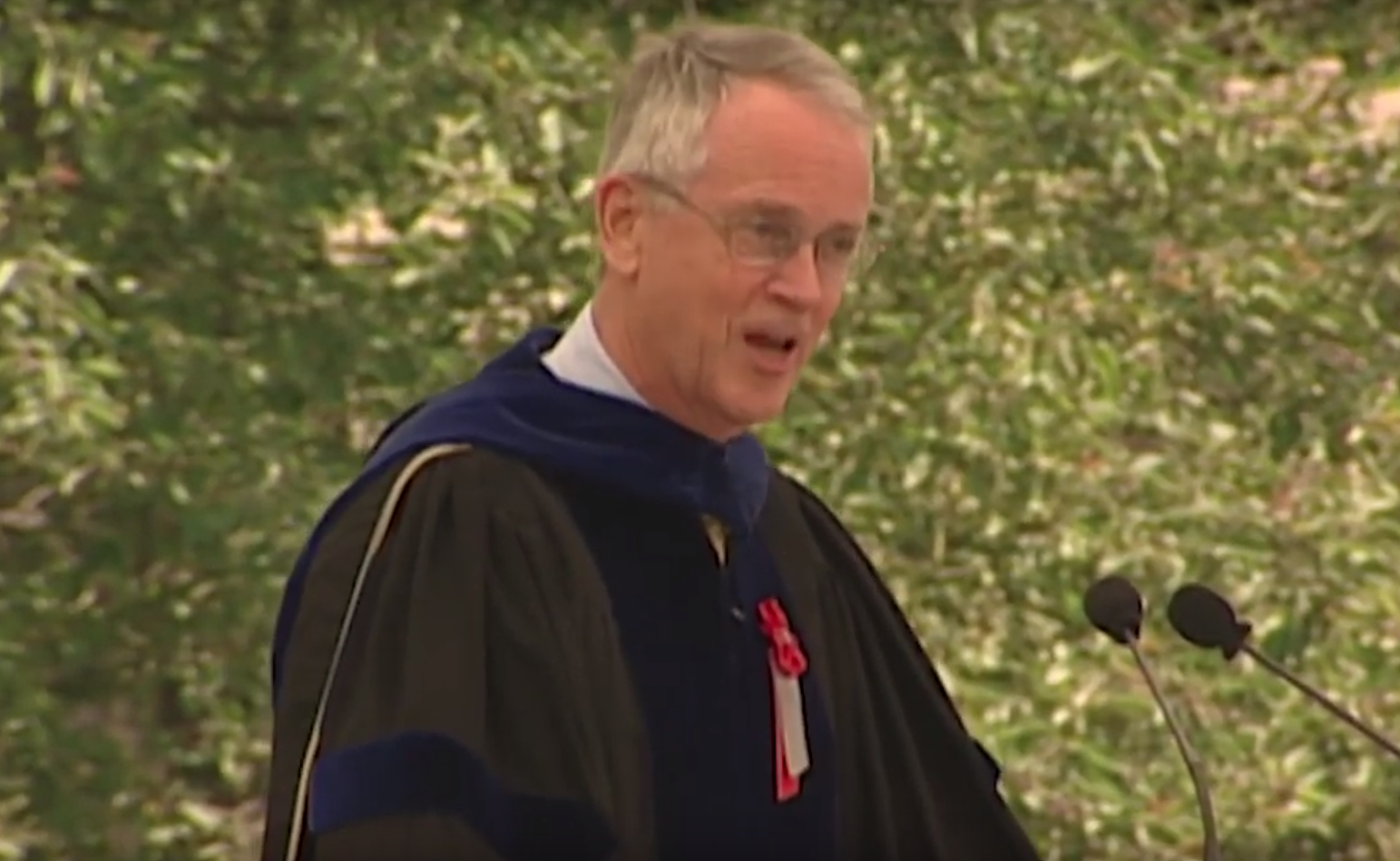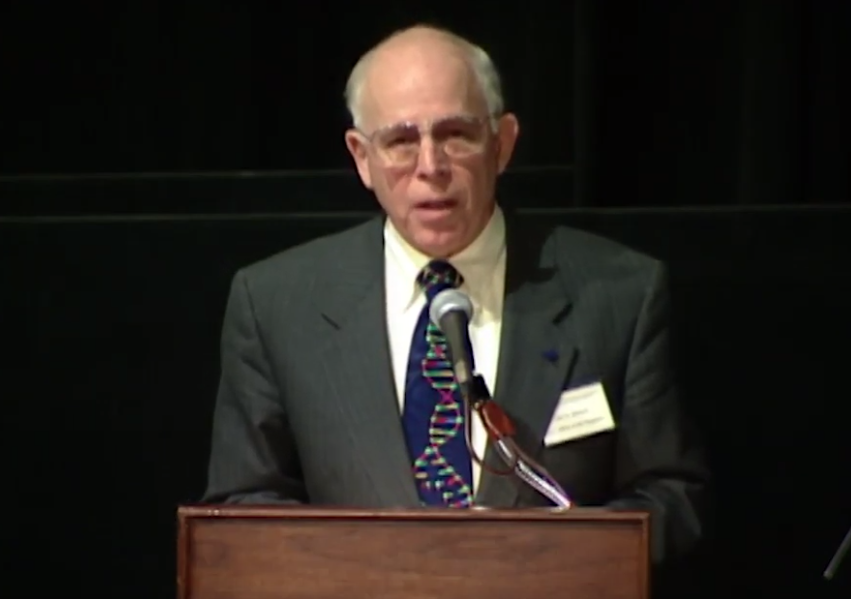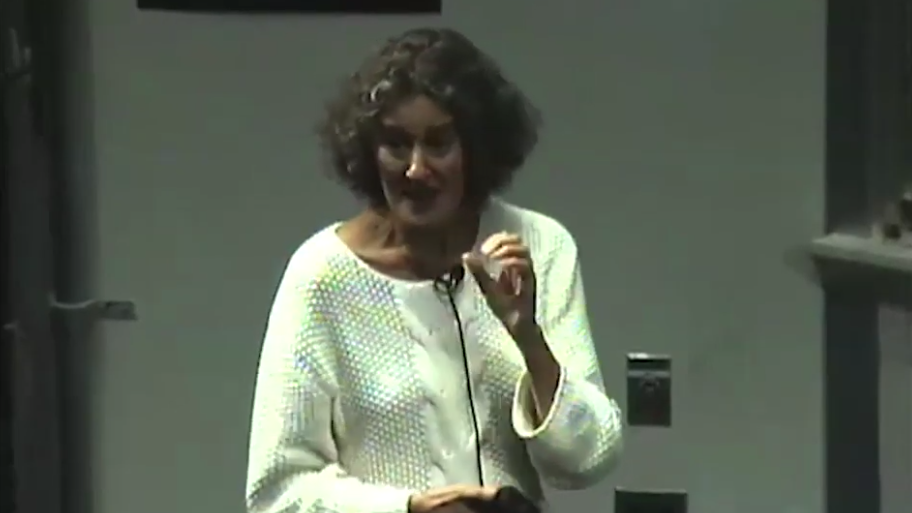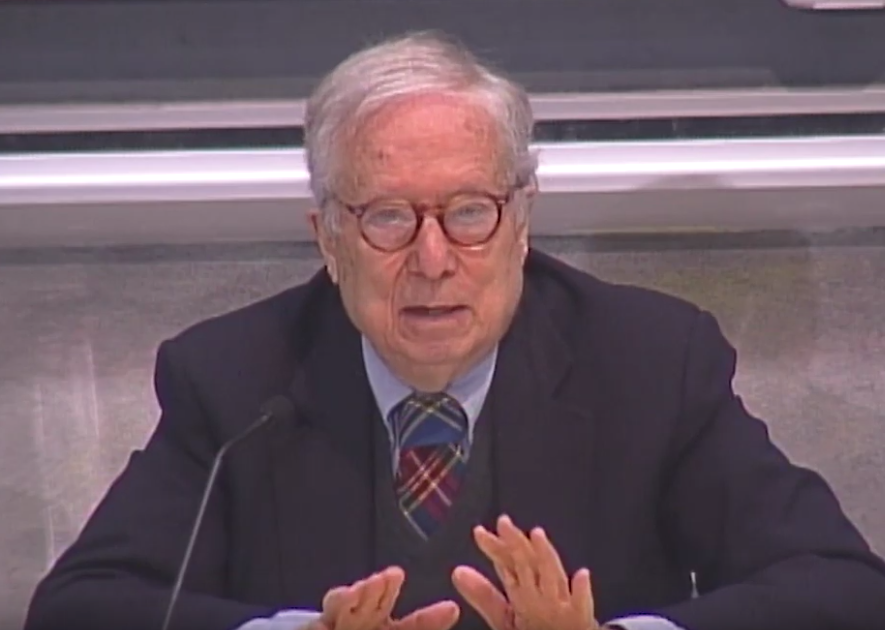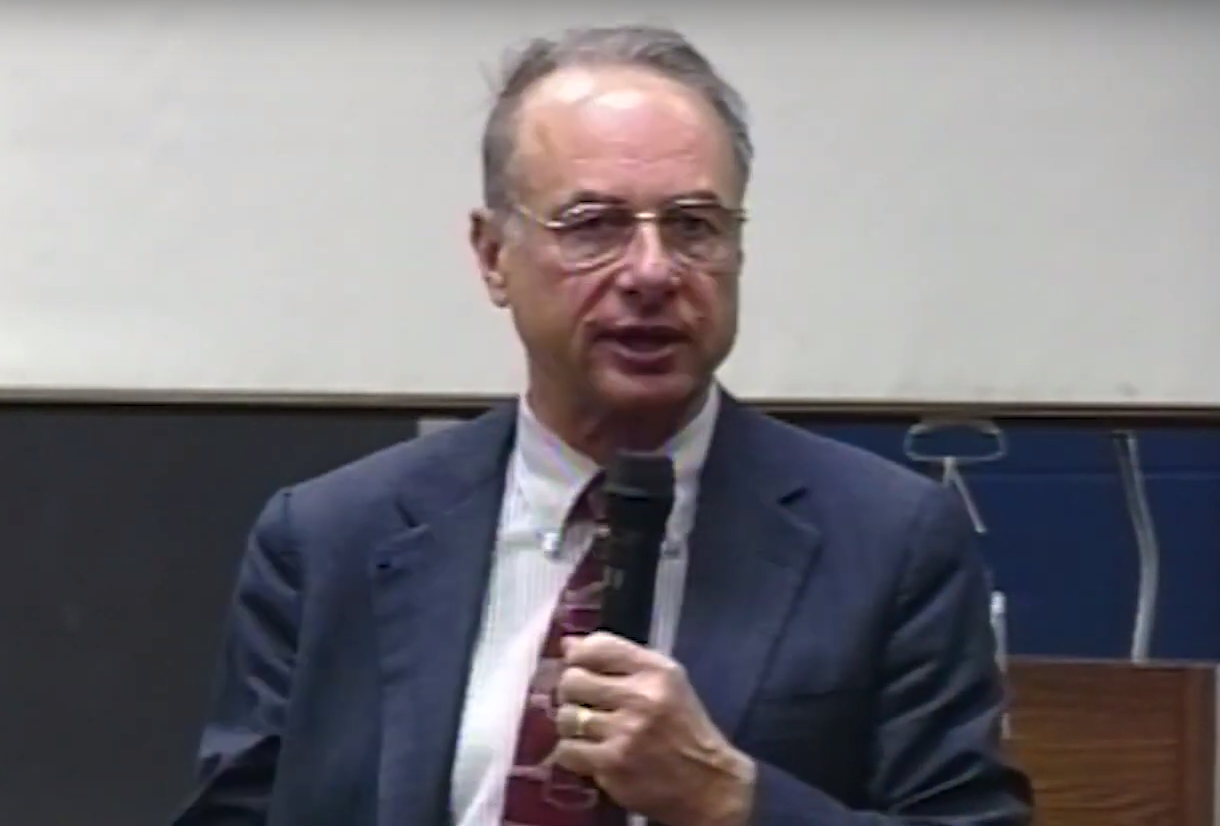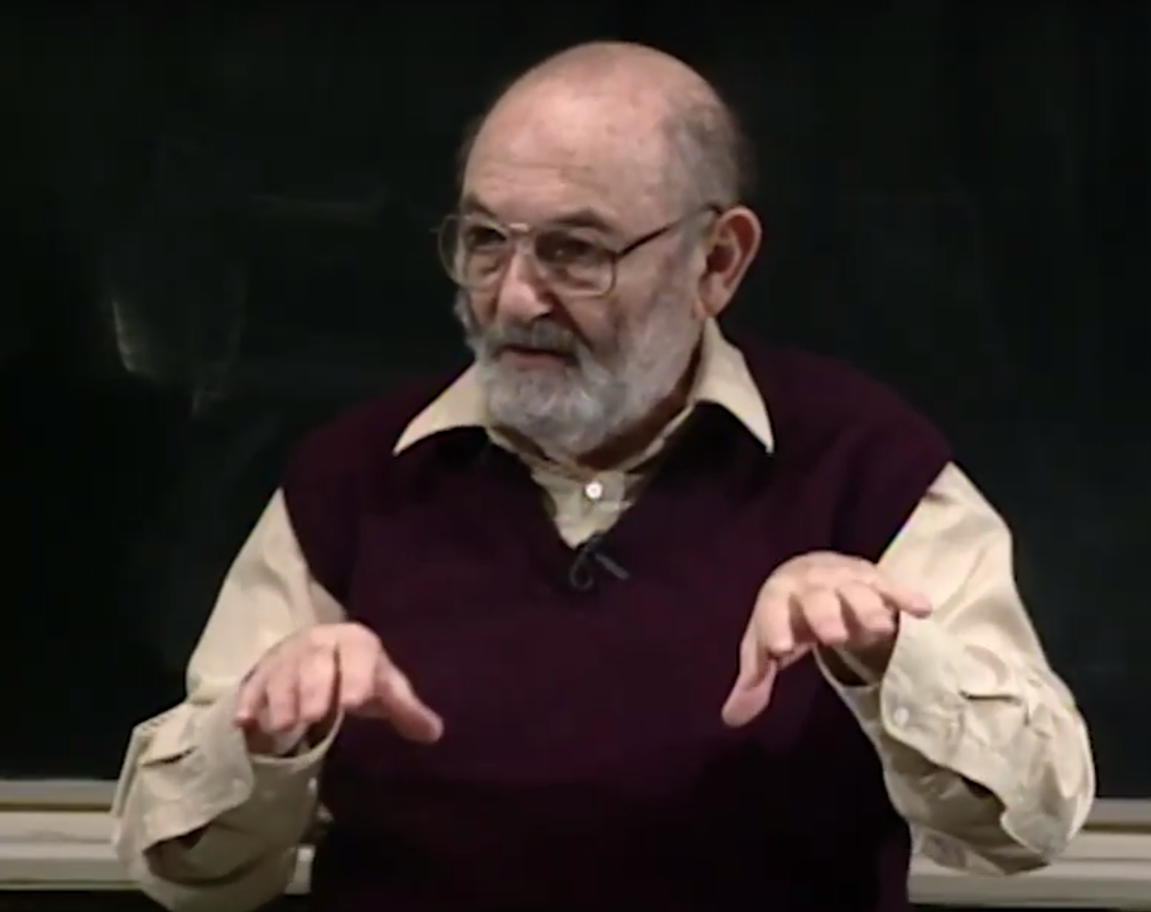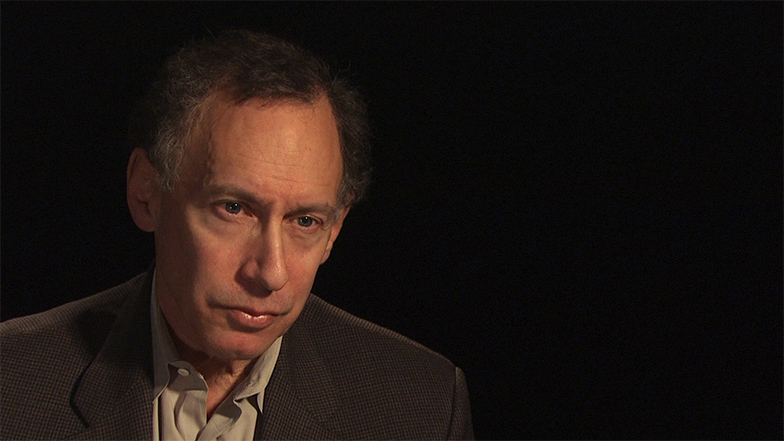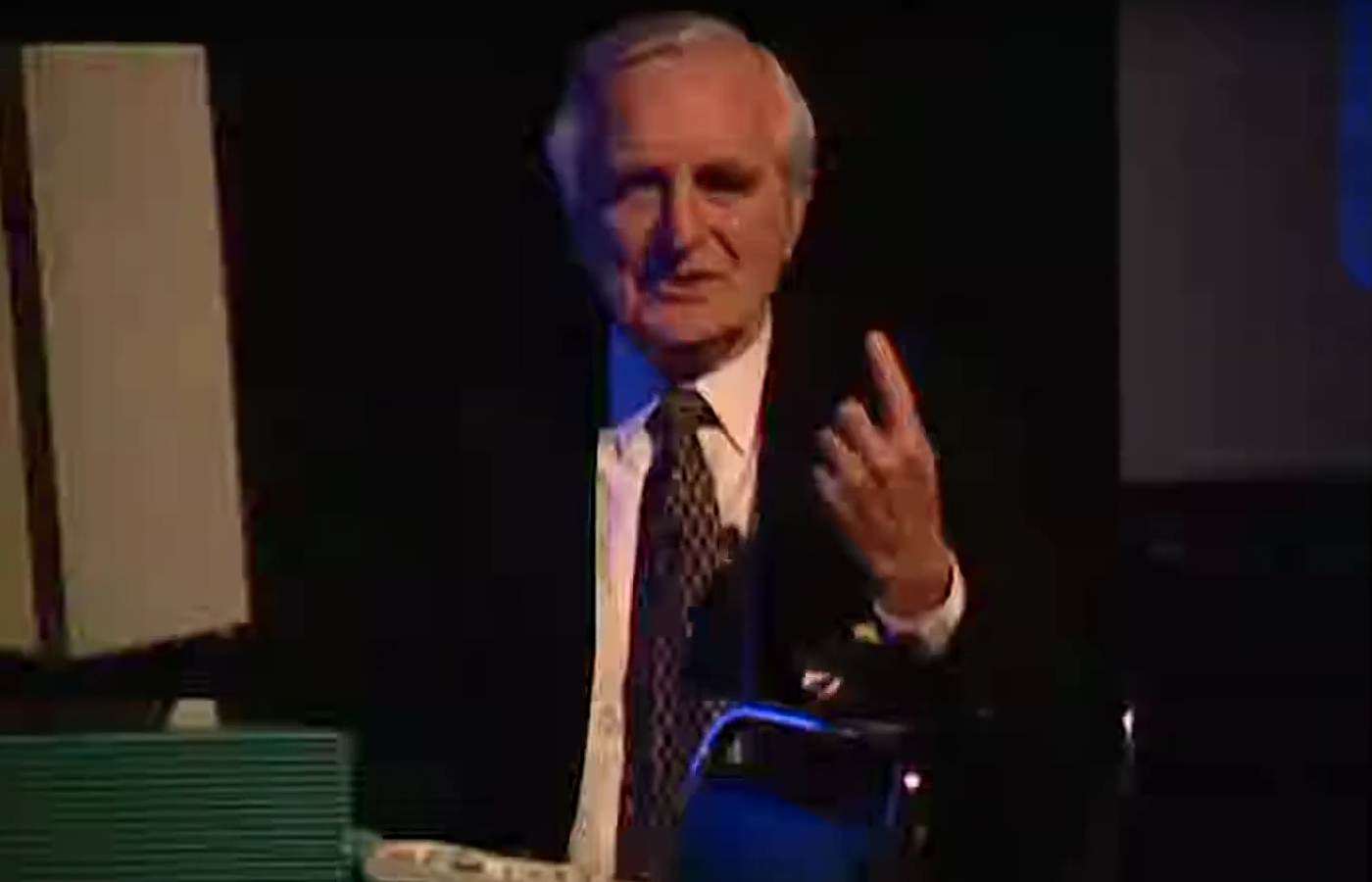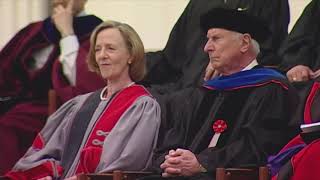Riccardo Giacconi, “Progress in the Study of the X-ray Cosmic Background” - MA Space Grant Consortium Public Lecture at MIT (4/7/2004)
YOUNG: I'm Andrew Young. I'm the Director of the Massachusetts Spacecrafts Consortium. And this is one of our enjoyable events that occurs annually, to invite a distinguished lecturer to come up here to Cambridge and talk about an aspect of space research. There are many other activities of the Massachusetts Spacecraft Consortium. I urge you to keep up with us by consulting the website, MASGC, which is listed on the back of the program for today's event.
All of these events are open to the public. And you're welcome to participate. We are also the host to a spring seminar course, Modern Space Science and Engineering, which meets every Wednesday at 3:00 and those lectures are also open to the public and the schedule is on that same website. And incidentally, for those students here who are registered in the course, would you, at 4:30, congregate up where Professor Hoffman and I are sitting now and we will go over some course business.
With that I would-- as well as take attendance. OK. With that, I would like to turn over for the introduction of today's distinguished speaker, the co-director, turn this over to the Co-Director of Massachusetts Spacecraft, Professor Jeffrey Hoffman, who had hands on experience in space with one of Professor Giacconi's key contributions. Jeff.
HOFFMAN: Thank you. As Larry Young says, this is one of the more pleasurable events of the year when we get to invite distinguished speakers to share with us some of their experience. And today's speaker is more distinguished than most, if I may say. I don't want to go through year by year his entire life history. Hopefully all of you, when you came in did get a copy of the program, and there are two full pages detailing Professor Giacconi's contributions.
I will say one or two things by way of highlight however. First of all, the work for which he received the 2002 Nobel Prize in physics was really involved with the birth of a new science, which is X-ray astronomy. As most people here know, astronomy for centuries was limited to what we could see with our eyes.
When the Nobel prizes started to be awarded early in the 20th century, for almost the entire century, no Nobel Prize ever went to an astronomer. And there are numerous urban legends as to why this is which I won't go into. But that tradition was happily broken when Martin Ryle and Tony Hewish won the Nobel Prize for work done in radio astronomy. And now we have another Nobel Prize for work done in X-ray astronomy.
However, Professor Giacconi of course, was not satisfied to remain in one narrow region of the spectrum. His work as the first director of the Space Telescope Science Institute, which managed the Hubble Space Telescope, both through thin and through thick, involved visible and ultraviolet. He went on in his work as the director of the European Southern Observatory to work on ground base, visual observation. And now as president of AUY, he's responsible for managing the National Radio Astronomy Observatory.
So he really has spanned the entire spectral range of astronomy. And in fact, their newest project is the Atacama Large Microwave Array, so yet another region of the spectrum with which Professor Giacconi is becoming acquainted and lending his expertise. It's a unique opportunity to have somebody who has really started a field and has turned it into one of the most productive areas of astronomy.
And Professor Giacconi, I'd like to ask you to come up and share with the audience your insights into what we've learned about the background of X-ray astronomy.
GIACCONI: Do I have-- no.
HOFFMAN: It's working?
GIACCONI: Yeah.
HOFFMAN: OK. Thank you.
GIACCONI: Thank you, thank you, Jeff. It's nice to be back here, see a lot of familiar faces, old friends. I spent a lot of my career here in Boston, in Cambridge. And so it's always a homecoming.
What I will try to do today is, I will not try to give you a historical correct-- how do I get it lower. I mean I hear, I hear,
HOFFMAN: They'll adjust it for you.
GIACCONI: OK, fine. I mean, I am hearing myself with echoes and so forth. So what I would try to do today is to take a thing, a problem in X-ray astronomy and which actually happened to be discovered, the X-ray background, happened to be discovered in the very first rocket flights, which revealed the existence of celestial extra solar X-ray sources, and then tried to follow the progress in understanding what this background was, until fairly recently, I mean this year, last year.
And that allows me to go through also the technological development, which was involved and the progress of the field with respect to sensitivity, angular resolution and so forth. So by discussing the X-ray background we touch on a lot of topics. So the first thing is the 1960, '62, when we started looking at the possibility of doing science in space.
And in particular it had become quite clear by then through the work for us those old Herbert Friedman and his group at NRL, who had used captured German V2 rockets to put on instrumentation and study the X-ray emission from the sun, that there was great advantage in working in space and the ability to look in regions of the spectrum in which a light would not reach the Earth. So there was a general interest in looking at ultraviolet radiation gamma ray radiation and X-ray radiation.
I didn't know anything, happily, about all of this until I met with Bruno Rossi and he suggested-- he was chairman at the time of Space Science Board, discussions that occurred there which included many participants, but he transmitted this information to me. And for some reason or other, that seemed to be a very nice thing for me to do. However my background was in elementary particle physics. And I detested loss statistics experiment.
My thesis was-- I was up at the Plateau Rozier, a wonderful place to ski, 3,500 meters, and it took me two years to collect 80 protons, in which I was studying interactional protons in lead. And I barely was able to confirm a fireball model. I thought, forget it. I mean, I don't want to get into another field, which is like that. And that's what you would conclude as soon as you start studying the emission from the sun, and you tried to put it at the nearest star.
That is, we were talking about sensitivities, which where five orders of magnitude or six orders of magnitude below that kind of experiment and which had been done up to then. So I actually considered for a while giving up, and then two things happened. One is, we went through, and by we now, I mean George Clark, Bruno Rossi-- George Clark, [INAUDIBLE], Bruno Rossi and myself, a brief review, as physicists will do, right? What is the problem? What are the expected fluxes? How do I do a crucial experiment?
And what we found out was, that what people have been trying to do was not adequate. Because the brightest sources we could conceive were in the sky would give us something like ten to the minus seven, the flux of the sun, 0.1 photon per square centimeter per second. And so the question was, could you start building detectors that would be sensitive to that kind of radiation? Turns out the answer was yes.
But also at the same time, by chance, I mean, since I had been thinking about focusing my protons there on the cloud chamber, by chance by reading Pfleuger, I came up with the idea that-- well, I learned that it was possible to have a total external reflection from surfaces of X-rays. And the immediate thing, as soon as you know that, and then you have had a mother like I did, who is an expert in projective geometry, you come up with a paraboloid as a concentrator for the X-ray flux.
And that was actually done before we started any real detailed instrument design, because it was important psychologically. Because it told us that even if we had to go six seven orders of magnitude, ultimately we could do it. And so, it wasn't useless to start with simple experiments and then a long technological development for the X-ray telescope. And both started at essentially at the same time, 1960.
Now, this was the payload, which was first successful, the payload this is the inside the rocket shroud. So imagine a shroud around it with three windows. OK, one, each, one, two, and so on and one that you don't see. There were counters. And to make it simple in my mind, I think of this triple-A changes between this instrument and what had gone before.
The change number one is the area had increased by a factor of 10 or 20 with respect to what had been done before. Then two, second day, anticoincidence. It turns out that the background of x-rays is about one particle per square centimeter per second. And if you're trying to find sources which are 0.1 photon per square centimeter per second, then obviously, if you can eliminate the background due to particles, that would help you by a tremendous amount.
And the third way, which had not quite been realized was the following. If I tried to scan the sky with three arc-- three degrees field of view, then my probability if I launch a rocket, my probability of finding a source anywhere in the sky with this small field of view is about 1%. So in principle, I should fly 100 rockets to find one source. I mean that doesn't--
Furthermore, even if I find it, so to speak, meaning if I cross it, then because I only have a small field of view and the rocket is rotating, I would not collect photons. And so in effect, you could show that those instruments would never have been able to detect Sco X-1, the brightest source in the sky. So when we finally flew this instrument, there were two characteristics which then introduced the subject that I want to discuss in the rest.
One was that we were able to see the first star, so to speak, or stellar system that emitted X-rays. And two, that it revealed a background, a uniform background, which we could decide was a background due to radiation and not a particle. Because we could actually measure the spectrum by having two counters, whether this actually shows the anticoincidence without the counter, no this has the counter in it, which had different windows, one thicker than the other.
And so you could, roughly speaking, measure the spectrum of the X-ray radiation that went through. So this is all to introduce this picture, which is, what we adopted was the anticoincidence, as I said, the larger area and a very wide field of view. This field of view is about 120 degrees. So essentially there was no baffling. There was no attempt to reduce it.
And what we found was this very strong source, which I'll move along and not spend too much time on that. That's from my [? fed. ?] And then a uniform Bell curve all over the sky. And we concluded from-- we were able to conclude from this, that this was a Bell curve which very probably had an extra galactic origin.
OK, now, I went through all of the arguments. There was no evidence of increase in-- as you went through the [? eclipic ?] or when you went through the Milky Way and so forth. That is the background which remained to be explained for-- thank you. Hey, I didn't know. All right. OK.
That was the background that remained to be explained and took about 40 years to explain. Immediately upon finding this, a contribution to cosmology was given, because-- which was interesting, and negative, so to speak. This background, big as it was, and it was very big, because there is no trace over the cosmic ray component here-- was absolutely much smaller what one would have computed in the hot universe model of the continuous creation theory.
So Hoyle immediately realized this. And one of the things which is fantastic here is that, just because he hadn't thought about X-rays, he hadn't predicted it. Otherwise he would have predicted that the sky was going to be awash with X-rays. But it's interesting that just a negative statement essentially killed that particular theory.
The other question, remember historically, that this is the time of finding the three degree background radiation. Then there was the measurement of the gamma ray background from the galactic center. And somehow, the idea that the background carried information of cosmological significance was around, let's say. So in effect in 1963 when we had these data, we thought-- we tried to think about what the background was all about.
Burbage was the first to suggest that this background could be due, not to a diffused emission, but the combined radiation from the distant galaxies, in which since we didn't have any angular resolution, then the flux would all be confused together. And so it dictated the design of the X-ray telescope we ultimately wanted. I'm trying to interweave the fact that finding interpretation or finding and design of the next experiment are very much a function of what you think that you're doing.
So what I thought I was doing in '63, I proposed at one point to meet that X-ray telescope which had the virtue that it could image the X-ray background with-- if you-- was uniformly distributed with an angular resolution of 1 arcminute so that we would decide whether it was done with individual sources or not. OK, so this was the first step. Now we didn't do much more than this.
There wasn't any major sorry-- any major change with this until 1970, we flew a simple X-ray satellite, which if you wish, it's just a bigger counter to-- one on each side of the spacecraft. The field of view is the important thing. Here is one half of the square degree by five square degree. Then a five by five field.
The satellite was launched by Kenya. And since it was launched on Freedom Day, Uhuru was called Uhuru. Also, because there was so much better than the NASA SAS or ABCD or whatever. Uhuru, that's what we really felt. So what is the purpose of the satellite is to do a scan of the entire sky. As the plane of the-- as the days go by, the plane of the sky changes. So you have intersection. You could find the position of sources.
And this was done over two years or four years. Now here is one scan. And I mean this is the Sco X-1, the first star that we had seen and that prevails on the whole sky. This is in galactic coordinate. Here you see now that scale expanded and you see how many sources. We see it's over-- what I want you to do is to ignore all the sources for a moment.
And here's the background, still there. OK? And is in fact, the largest background the largest contribution of the background to the detection of sources. Now, the results, I want to introduce two concepts, which then allow me to go on. This is the result of the catalog from the all sky search. And it's a galactic coordinate. This is the Milky Way. OK? And most of the sources that you see here, which are represented by dots of increasing size depending on their intensity. This is Sco X-1, the most-- the brightest one. Our galactic.
And most of the other ones, or almost all, are extragalactic. They are diffused around. Two fundamental findings of this satellite were, one, the discovery of binary X-ray system, which involved the-- well, sorry. I inverted the order.
This is-- the first one was the discovery of hot intergalactic gas. What is this gas? Here is a photograph. This is taken much later, not in Uhuru. This is a ROSAT picture, the X-ray. And what underneath is a, I think, it's a [INAUDIBLE] picture or something. Here you see galaxies. There are thousands in this cluster. And here you see the distribution of X-rays, which are emitted, not concentrated on each galaxy, but in the space pervading the galaxy.
Now that sounds interesting. However, the most salient point is that more, 10 times more, mass is in this gas at very high temperature, which cannot be seen in visible light than is contained in all the galaxies and stars represented in this picture. OK, so this was finding a new state of matter in which very high temperature gas was emitting X-rays by thermal bremsstrahlung.
And as we go along will see why I wanted to mention this. The next thing-- and this I won't go through this. The next thing was the discovery of this binary system containing a neutron star or a black hole. And the reason why I'm bringing this up, that this was not in any particular [INAUDIBLE] was that we discovered binary system in a collapsed star. In a normal star, gas would fall from a normal star up to the collapsed star. And it, the collapsed star was emitting pulsations.
Now the question that arose was are these pulsations emitted at the expense of the rotational energy of the compact star as is the case for pulsars. And the answer is no. In fact, this X-ray source is not slowing down its rate of rotation, it's acquiring energy. And it is acquiring energy because of the inflow of gas onto its surface.
And this mechanism, which is shown here, if you wish in a diagrammatical way, this is gravitational equipotentials. Gas from the normal star falls in the deep potential well of a neutron star for instance, and acquires more energy per proton that you can obtain by nuclear fusion. So this is a very powerful energy mechanism. And it's now been extended. In Uhuru, as a result of Uhuru, stop.
These are not-- this was one of the sources, which is periodic, which I mention now. Other sources show nothing. And then there are very erratic sources. And by bringing it to the attention of the astronomical community this unusual behavior, then very good positions were obtained, some from the MIT group some from Uhuru itself, MIT group using rockets.
And then an optical identification was made by Webster and Murdin. He determined that the mass was ten solar masses, six solar masses. There are very rapid variations which involve the whole star and they are very rapid, because these are at the level of milliseconds. Therefore, the object must be very small and is very massive.
And it had been shown by Rhoades and Ruffini that no neutron star could have a mass greater than three solar masses And therefore this was by definition a black hole. And what it means is we simply don't know any physical law that prevents this star from indefinitely collapsing. Now, the point that I am trying to make here is that, without going into all of this, that there was a new source of energy due to gravitational infall, which is very efficient and a model for what is happening naturally in the nucleus of active galaxies and quasars which explains why the tremendous amount of energy which is emitted by this object.
These two facts, that is the idea that very energetic emission in X-rays comes from the nuclei of active galactic nuclei and is powered by gravitational infall, gives you one potential explanation of the X-ray background. The possibility that hot gas diffused throughout the universe gives you another potential interpretation. And the difference between the two is that one will be a diffused continuous emission and the other one would be a point source emission.
OK, so there were some-- now again coming back to Uhuru, there was-- here is the background, as you see, is dominating. I mean, here is the cosmic rays. And these are very strong. These are very different than what you see in the visible light sky, right? It's not like extra galactic component or the visible light sky dominates the sky. I mean that would be that it's light all the time so to speak. But it isn't. But in X-rays it is so.
Then there was a finding, which I thought was very suggestive. If you take the sources which are at low galactic latitude and you plot how many of them as you go weaker and weaker, fainter and fainter, you find at a certain point, you stop increasing the number because you are running out of galaxy. If, on the other hand, you do this for extra galactic sources, their number keeps increasing as you go to fainter and fainter magnitude as if the cosmic expansion were balanced by evolutionary increases.
Now, this actually was done by Matilsky, who was, I mean a real '60s kid, I mean, motorcycle type. But that was a very profound finding. OK. So here one could be led to the conclusion that, OK, so if the extra galactic sources keep going up and up and up, then we have the exponential background, right? And in fact, this was suggested naturally by [? Bolger ?] and [? Sutton. ?] If all sources extra galactic were emitting like a quasar, then we would explain the background.
And here again, I'll jump this away. Now, the other question was, well, what was the spectrum of emission of the background? And that was-- it looked somewhat simple. This is a composition by Gorenstein, I believe, of, you know, the emission from different sources. And it was clear that you could explain it either with the thermal bremsstrahlung spectrum, which is shown here or by two parallel spectra. And this was about what we knew.
Now, the next piece of important information or that seemed extremely important at the time, was this one. That is, this is now 1978. Uhuru was 1970. This is 1978. Here, one flies. It's a very large counter. And it finds the spectrum of the background and here are different fits. And as you see, it fits perfectly the thermal bremsstrahlung spectrum at 40 kilowatts. And this became ingrained in everybody's mind, and therefore there was the conclusion, well, this had to be thermal bremsstrahlung from a hot gas filling the whole universe.
Now, never mind that this actually require more gas than the total mass of the universe. I mean this was-- and that if it existed, you would have to explain how, after cooling it at three degrees, which is what we see in the microwave background, then you were able to reheat that 40 kilowatts, which were a little problems. But never mind. So this was OK. And I think that beyond that I stopped going with the known imaging experiments, not using the telescope. Because there was no more progress that was possible.
And here, I just wanted to show you why X-ray telescopes can be important for X-ray astronomy. Here is the absorption in the atmosphere. So if you go up, you see more, because this is absorption at I think one half, here. 100, 110, 1/2 and so forth. Here is a spectrum of potential X-ray source.
And I think it was Conconi who pointed out that in normal high energy sources, the number of photo decreases as the energy goes up. It's an empirical law if you wish, but it worked. And here is the limit in which you can reflect with total external reflection X-ray efficiently at about a kilovolt or up to 10 kilovolts. And here is the window of detectors that we can build. I mean, it's difficult to have detectors which go to softer and softer wavelength.
So in this particular, the reason why X-ray telescopes are useful is because they work here and maximize in a region n which you have the maximum statistical number of photons coming in from a source, OK? Now why wasn't this clear? Because it took a long technical development to come up with telescopes. And OK, this was in 1961. I mean, a statement of what a telescope would look like. You need a double reflector to make an image.
This had been done by Wolter in 1952 or something. Because he wanted to build microscopes. He ultimately never could build them, because they were so small he couldn't actually do this. But for telescope where you are talking about large surfaces, then you could polish these inside surfaces to very high accuracy. And the trick was that you have to have extremely good surface polish, much better than what you normally need for optical telescope down to three photons from all the surface roughness.
This was hard. It took many years, little telescopes, OK, replica telescopes, [INAUDIBLE]. This was the first serious telescope I think for solar research, and which already had some of the features that would be necessary for stellar research, where you need more area. So you make many surfaces one inside the other. This particular task flew on Skylab, the mini space station, 1973.
It took a picture of the sun. And I use this to show you, yes, the technical progress, but also the fact that it's amazing, that just this picture tells you the very important role of magnetic fields in the containment of the hot gas and in the production of flares. So that revolutionized solar X-ray astronomy, and actually the study of the corona. This was Vaiana and Van Speybroeck. Now here's the first application or attempt to use an X-ray telescope for stellar astronomy. Surfaces had to be much better polished, more area.
Here was the interest of doing many things. Four groups were involved. Goddard, MIT, America Science of Engineering, Harvard, and Columbia. And spectrometers were put here. And you could turn, these lazy susan, and had a solid state spectrometer, imaging proportional counters, full [INAUDIBLE] increase, et cetera. I will just focus, because you know, as a mono maniac, I was still trying to find the source of the background.
So what I did was to choose a region of the sky where no X-ray source was known. And we pointed to this for 10 days, a million seconds. And, this is mostly background. There are three sources here, one, two, three. And to give you an idea of what we are dealing with, the fainter sources that we were seeing was something like 10, 11 counts. So it was one count, one photon a day that we would collect.
That is also the limit at which we are going with Chandra, exactly one photon per day, but now to much fainter sources. But X-ray astronomy is not easy is what I'm trying to say. Here was the same field. Unfortunately, I should reverse it.
But those three objects are identified now with stellar looking object, two of those are quasars. One of them is a star, a normal star. So one can draw the conclusion, and here I'm going to the very early Uhuru data. And then you see this is where the galactic stuff, extra galactic stuff, Cox1. And the deep survey goes down by two or three orders of magnitude in sensitivity. And yet this trend of the increase in sources as you go fainter and fainter continues.
Now, the problem with all of this is that these measurements are made in a specific region of the spectrum, one to three kilovolts. And so, there succeeded long debate, because of what was the spectra content of these radiation and whether this was just a fluke, where we were measuring a background that really wasn't the background that one would like to understand.
Now that was very difficult to deal with because at the time, we just couldn't go to higher energy, despite the murals were not good enough and so forth. Now however, there were some interesting points. And this was one of the attempts we made to put some rationality in this research.
What had been found was that spectra of the-- so the claim for the proponents of a discrete source origin for the background, basically we're saying that, active galactic nuclei, C4 galaxy quasars, C4.2 et cetera, would make up the background. For the few sources for which the spectra had been measured, spectra indexes, which were very steep, that is much more low energy than high energy stuff were found.
And it was very difficult to explain therefore, how the background that looked much harder than what each individual sources could be generated without assuming evolution or changing the spectra. So what do we try to show was a kind of reasoning of absurdum, which I think had to come from a Jesuit education or something. I don't know.
Which was like this, if you assume that 50% of the sources are due-- or 70%, depending on what you like to do are due to these individual sources that we have measured, whose spectrum we have measured, then the spectrum that is left has to be very hard. Because we are taking a spectrum, which is soft, spectrum that is left is very hard. Now what is the-- could the spectrum be a thermal bremsstrahlung spectrum? The answer is no.
There is no way you can reproduce the slope of the spectrum with thermal bremsstrahlung from a optically thin gas. So in order to explain by diffuse emission, what are the residual background is due to, you have to imagine that you have gas, yes. But that you have to have absorption in the gas, such as the low energy suppressed and you allow high energy to come through. Now in order to do that, you need balls of gas of a certain optical depth.
And once you-- and you can do it one of two ways. Either you have enormous balls of gas with very low density or small balls of gas with high density. So what we said, well, how do we decide between these? Well, we decided on two grounds. One, that we wanted to have enough optical depth to get the absorption effects we wanted. And second, that the total number, the total mass containing all of these balls of gas, which had to be millions because we were seeing the background to be very homogeneous, could not exceed the mass of the universe, which seemed a reasonable constraint.
Well if you put that constraint, that immediately collapses, says, that all of these balls of gas that you're talking about that should fill the universe uniformly have to collapse down to 100 kiloparsecs. So that means that would be the size of our galaxy. And therefore, it shows ad absurdum that these postulated sources of the continuous background actually have to be point sources.
Now, this was not-- this was a paper, I think one of the better papers, I ever. But actually it wasn't understood at all. My referee said, well, why don't you talk about a physical characteristic of these objects you're describing? And I tried to explain, but I-- [LAUGHS]. Anyway, interesting. So in any case, I claimed that by 1987, the problem with the background was solved, that is we knew it had to be due to discrete sources.
However, we had to prove it. And we had to show that the spectrum, et cetera. So now-- and I won't-- there was a flight of a German satellite, York and [INAUDIBLE] built ROSAT. We went with deep surveys. I was fortunate enough to be involved. I mean, this was the group. And we found 70% to 80% now the background-- again, remember at low energy.
The spectrum of sources, et cetera, et cetera et cetera. And still-- and the composition, what were the sources, each one identified. 39 at GN, one galaxy, three galaxy group, three stars, four unidentified objects. Still there was this problem on the spectrum. So finally, it only got solved with the advent of AXAF which only happened to be launched in the year 2000.
Now, AXAF has the angular resolution. This is not allowable to discuss, pulsar emissions, but it has the angular resolution to give you this direct picture. This is no artist conception. This is the picture of the Crab Nebulae, showing the shockwaves and so forth. There is a movie of it, but I am technically challenged in showing it to you. And I just wanted you to understand the power of the instrument.
This is as good a picture as you can take with Hubble, essentially of the Crab Nebulae with the invisible eye. Naturally I didn't take that picture. My time I devoted for looking at the region of the sky with no source was known before. And I went for and asked for a million seconds. I got a million seconds. And here now is the field of view of the CCD, which looked at this region.
And we are finding a source density, which is really enormous with respect to what we were finding before. Because there is something like 300 sources containing a tenth of a square degree. So this is not as high as the source certainly we see in Hubble. Because we are there, we are looking at galaxy. But basically 90% of the sources are black holes emitting energy by the mechanism which I was explaining to you before in full from an accretion disk onto a supermassive black hole.
And the rest are interesting in their own right. This is an attempt to show in a collar-- I will go through this. Here is a summary of where we are now in sensitivity. So this was my chance to show you that we went from 10 to the minus seven 10 to the minus 17 or several times 10 to the minus 17. And this was in 40 years, which is not bad.
It's equivalent to going from the naked eye to [INAUDIBLE] or VLT. So it's OK. The field is more. Now here is the contribution of those sources. Now you can sum all those sources. OK, sum all those sources. And this is big arrows, and this is the [INAUDIBLE] of the background. So you see that one of the problem saying, how much of the background is due to individual sources? We don't know, really, we don't have any good measurements of the background.
But, OK, there could be some diffuse background still there. And that would be very interesting. If one could actually prove that it exists. Now the next thing which was interesting is, remember we are having very few photos. So when we talk about spectra, we have to sum. So this is the summed spectrum of all of the sources with something of the instrument's signature, and then a fit to the background spectrum.
And as you see it essentially reproduces the backer of spectrum completely. Now this is a conundrum, right? Because when we measure a few sources they seem to be different. Now we're measuring them all and they fit. So something is happening. And here is the different increases by the number of sources.
And we can go now to 10 kilovolt, which is kind of nice so that we don't have this problem that we don't see the high energy sources. And you see here that at the low energy, the number count of sources seems to be turning over here and here. And at the high energy, five to 10 kilovolt, it seems to keep going and is going faster than in the other spectra region.
Here is another attempt to show, is an attempt, I mean, to show why what is happening here. But, each one is a source. We don't have enough to measure the spectrum precisely. So we do take what we call a hardness ratio, hard versus soft ratio. And what you are seeing is that you go fainter and fainter here, the hardness ratio increases.
So what it is, is that the sources are changing their spectrum or you're picking up different sources than what you were picking up when you were looking at-- this we can-- when you were looking at bright ones. And here, for instance, the same trend, the spectral slope, which is given by these gamma is going down, as you go to lower and lower fluxes. So the spectrum is becoming harder.
And now the next step, OK? What are these sources? So this is the overimposed-- Chandra, as you can see, contours in x-rays. On the Hubble, SES, large camera, deep survey of the same field. And what you see is two points. One is that it's really important to have that very high angle resolution. Look at this, for instance. I mean, at the very high angle resolution of both Chandra and of Hubble to identify sources.
Now once you have identified the sources then you can go to spectral measurements. And there, it's important to have even larger telescopes than Hubble. So much of what I'm going to discuss now has been done with Hubble, Chandra, and the VLT, which is the European southern observatory four emitters telescope. It's the largest aggregation of telescopes in the world.
So what do we find? OK, the first thing we find is that-- OK, this was simply said, the hardness ratio seems to go-- has a dependence on the brightness, increasing brightness of the source. If you measure redshift you can get increasing brightness. These objects, which are stars are quasars type two, which one had been known before.
So they are objects in which presumably you're looking at them, face in, I mean without the absorbing effect of the of the gas or their own galaxy, increasing absorption of the galaxy. So these have softer sources because you're seeing them like this. These are the harder sources because you see them through the gas of the galaxy.
And they tend to be somewhat of lower emissivity. Increasing emissivity. Here our sources which are very, very soft, minus one, and they're galaxies. OK so what we are seeing here is C41, C42 active galactic nucleus but they are all active galactic nuclear. And here we are seeing possibly some clusters. And here we are seeing galaxies.
OK, let's go on one more minute. The ratio between visible light, here, in magnitudes, R magnitudes and X-rays, is more or less what had been found before, these lines, one, one, 0.1, were found even with ROSAT. Here are the galaxies again.
Here are those objects that I was telling you that are soft. And here are the hard ones. And here are objects which are seen in X-rays, even very bright X-rays but are seen in visible light down to 28th magnitude. And I can assure you that observing objects at 28 magnitude becomes challenging, not only for ground based telescope, but for Hubble.
So we have been able to basically-- the reason why you're seeing the sources identified up to here is because it really is an eight meter telescope or ten meter telescope to measure the spectrum. And you can try morphological identification, et cetera, et cetera, et cetera. But basically what I'm trying to say is that the X-rays have allowed us to look at objects, whose nature we do not yet know. We need to a bigger-- a visible light telescope or possibly ALMA in the millimeter wave to actually identify these objects.
The next thing was, OK, so, what I'm trying to say in the closing remarks of this talk, over long, I'm sure is the following. That the problem of the origin of this background is gone away. Obviously, it was a non-problem. It was a fiction of the theoreticians. I mean it-- we just needed an angle resolution and powerful instruments to show.
But what has happened here is that now-- actually I want to go back here once. Now what do we have engaged in, no, no, no. Here we go. We have broken through this fog. We are seeing the individual objects. And now we study them.
So the first thing we did for-- I mean, the reason why I went back, I wanted to pick up this group, which is galaxies. And the first big group we were able to do is to measure the rate of star formation in X-rays in galaxies at fairly large distances from us. And it's an interesting problem. It was compared to the known or measured [INAUDIBLE] rates in other wavelength. It was 90 degrees.
But this is the stuff of measure rates or binaries it turns out. Here, another aspect of the result is that when you distribute these sources, in redshift bins-- you see these clumps, which have been seen in visible light. These are clumps which are observed in X-rays, which means these are active galactic nuclei. They are not clumps of galaxy, they're clumps of active galaxy or black holes or call it super black holes.
And finally, the study of clusters and the emission of clusters, the largest in assembly of matter, that discrete matter in the universe, this is a picture taken in one of these very deep fields, of a very faint cluster. And this was done not only by us, but also by the people, Bower, and [INAUDIBLE] and so forth, who had been doing the same. But this is our work and this is their work.
But basically we have extended the region in which we see clusters by several orders of magnitude. Again, a little dig to the theoreticians, which have been a pest in my life. We had a wonderful experiment which we had proposed, which was turned down not only by NASA but by ESA and by Italian Space Agency, on the ground then no cluster existed at this early epoch in the universe. Now I could kill them. But OK, that's their job.
Now finally, something that we have found out just a couple of months ago was, OK, now we have all of these sources. Do they vary? If they are accretion disk providing matter on a supermassive black hole, then as this amount of matter changes in time, then you should see changes in the emission of the X-rays. And what we find is, we find variability.
Now again, this was done in a very stupid way. That is, we plotted out the actual intensity that we would measure in the different observation types. And we found out that there was a difference from one observation time to the other. Now why-- two other groups that tried to do that and didn't succeed because they were applying overall algorithms that would measure this and that and so forth, very sophisticated in fact, software, but not as simple minded and revealing as this very simple kind of approach.
So I'm saying sometimes that you're too smart for your own good. Here, we did find sources which are valuable. And the most-- here is the plot I mean, I'm showing you very little. But the plot has to do with hardness ratio. So it says that the ones which are most valuable are the one which had the lowest hardness ratio, which has to do with type one and type two. That is again, you will not see absorption in the line of sight, because in the Seyfert type stew, you have to have scattering, and therefore you have dilation of [INAUDIBLE]. And this is the ratio of what happens. And this is very strong.
And again, the next slide shows this done now as a function of redshift variable and unvariable. And it shows that the most valuable one are they want in which the increasing absorption is lowest, which means that the hardness ratio is lowest. So this is just a repetition of that set.
So to conclude, I think that I can say, well, we have solved the problem of the background, I think. There may be an experiment to find out, is there really a new, some diffuser component. Second, we find many of these type of sources, clusters, GNs, galaxy, and then 10% are identified, which I am-- we are convinced that it may be something new that we haven't understood yet.
But we will need more powerful optical and radio telescopes and so forth to see it. I hope to see it within my lifetime. I mean, you know, I've been waiting 40 years. It seems real. OK, very high source density, the possibility to study. OK, one third of the sources are these sheets, just like it happens on the galaxy distribution.
And basically what the backgrounders don't do is this, is the deep study of evolution of galaxies, of GNs, and large structure. But I'll stop here. Thank you.
[APPLAUSE]
YOUNG: Not bad.
HOFFMAN: We'll have a little time for questions. First of all, I want to mention kind of an underlying theme in the series of lectures we give in this Modern Space Science And Engineering seminar series, is that there are fascinating scientific questions which can only be answered with recourse to space observations. And in doing this, we have to solve a lot of very sophisticated and fascinating engineering challenges.
And Riccardo, I think your talk has illustrated this perfectly. Fascinating scientific questions, and you've also taken us on a tour of the history of the development of X-ray technology. If I could ask the first question, what would you like to see as the next technological development, maybe to take us the next step?
GIACCONI: Well, I would like to, we need a little another factor of maybe 100 to make a real difference. So there have been--
HOFFMAN: You're always thinking big, I love it.
GIACCONI: I mean, it's you know it's three magnitudes in the lesson. Also I think that it's important that we maintain this-- I mean the thing that makes me happiest is in this last experiment that I was able to use Chandra, which I proposed together with Tannenbaum in 1976. I mean, and the Hubble that I was involved in directing. And then VLT, which I was involved in building.
So to me, they are all part of the arsenal. It's very important that we keep this capability in balance. I personally feel that the millimeter wave interferometry array, which will come in being in 2007 or 2008, the first manifestation is going to be a very powerful tool here to carry out this research.
I think it's important that we go on in X-rays because every time we turn around and we get new discoveries. I mean we absolutely did not know that there was this kind of spectral evolution in GNs, which still is not clear. I mean what-- no model we had on the X-ray background actually explained the data that we have seen. And so we need more area.
Unfortunately that has to be coupled to a high angular resolution. Because I mean you already saw-- first there is the Chandra spacecraft is more sensitive than the XMM spacecraft or the Europeans, even though XMM is larger because XMM gets confusion limited. So if you're looking to a nearby source where you don't care about confusion limit, then you can get a lot of photos. You measure spectrum more.
But if you're really looking to very distant sources, then you really need angular resolution to know what you're doing. So angular resolution, spectra resolution, and area, right? That's what we need.
YOUNG: Some questions from the audience? And I'll mention that we'll have a short question period and then we do have some refreshments and we invite you all to stay and enjoy the refreshments, talk informally with Professor Giacconi and with one another. And I'll remind the students that were involved in the seminar at 4:30, when Professor Giacconi will have to leave us, please come up to the front and we'll continue with our work. So, some questions. Yeah.
AUDIENCE: Riccardo, if you're trying to look at a background, of course, it's like a radio problem in the background. You can generate it in your equipment. You can generate it in a photo array from cosmic rays. And both of those problems were overcome.
Were they relatively straightforward? Did the require clever engineering or what?
GIACCONI: Well, the cosmic ray is-- we really don't have very effective anticoincidence against cosmic rays right now. But the cells of the CCDs, are so small, they are 20 by 20 microns, right? That the rate of cosmic rays is very low. And also, the DDX, which you see is different. I mean the position of energy comes in a slightly different way.
So you can try poor shape discrimination, which is being used, and also seeing if you have more than one pixel involved and so on. But it's rough I mean, we still have signal limited, which is an important point. So that is, we go 100 times and we have the adequate resolution, we are going to go to 100 times in sensitivity.
That's a big advantage for a telescope with respect to simply counter. Because a counter, you just increase the sensitivity of the square root of the area. But to have the sensitivity of Chandra would require a mile by a mile Uhuru. So and I don't think you could have done it.
So that was a problem. The other one you mentioned was--
AUDIENCE: Generated insight.
GIACCONI: That again, we used pulse shape discrimination on Uhuru. There were two counters side by side so you, OK, I mean, yes. But what not-- it wasn't a physics problem. I mean, it's not like, you know tried to invent an accelerator. No. It was OK but, like. Yes.
AUDIENCE: Hubble Space Telescope is not going to be serviced in the future. That's what is being mentioned in the news. How's that going to affect researching incident background and, for that matter, space research?
GIACCONI: But if I had my rather, I would, and I think I express the view of much of the community, that it would be nice that if we could be assured of a continued operational space telescope. At the moment, we have absolutely nothing with that kind of refinement. For instance, to look at morphology pf some of these objects, which we are doing now.
Or to make the statement that there is no object corresponding to this one, you have to add extreme procedural position and sensitivity. OK? On the other hand, you know that the well-known discussion, it is a general problem with NASA that they start the discipline, but they don't support it in a steady state. They find it very difficult to support a steady state operation of anything.
So for instance this problem will occur with Chandra and X-ray astronomy unless we do something about it. As soon as Chandra-- Chandra case cannot be serviced because it's too far, elliptical orbit. So as soon as that dies, then my estimate is it takes 20 years. I mean, ten to sell, and ten to build, right? It takes 20 years.
You know, my-- so, it's going to be tough. And I think that the only thing that sustains us really, is that altogether, astronomy is at a tremendous progress, right? And if you become frequency agile, so to speak, you know, to me that's happened I've gone from high energy to low energy as I became older and older.
So now I'm a radio. I mean I can't-- but anyway, the problem is that what should be driving you is the problem that you wish to solve. And you can solve it in a variety of ways. And you have to be reasonably agile in the sense that if you wish to use observational materials, you've got to use the observation of a material that either you can produce by building an instrument that is within your means. Or you get it from the virtual National Observatory, from the data bank, or Hubble.
I mean half the research on Hubble right now is done on archival research, not direct observation. And this is unfortunately, a prevalent trend. Unfortunately, because it creates a generation of astronomers who have never had to build anything. They just have to analyze data.
And the question is, who's going to build the next? and? It's a real issue about training and passing on a culture. But that's as it is. So I don't know. I answer you with too long. I mean, [INAUDIBLE]. Yes. No? OK. Are we done? Refreshments?
YOUNG: Well, just before we break for refreshments, we want to thank you once again for taking the time to come and talk to us. You do have a certificate of appreciation. Maybe, maybe not quite as significant hanging on your wall as your Nobel Prize.
GIACCONI: I don't hang anything on the wall.
YOUNG: But it's heartfelt. We appreciate it.
GIACCONI: Thank you.
